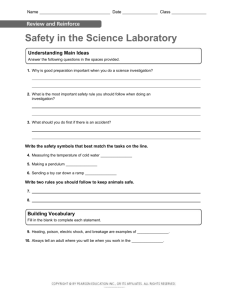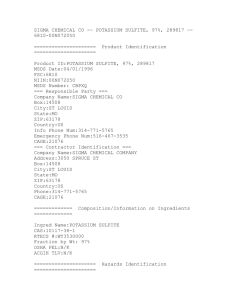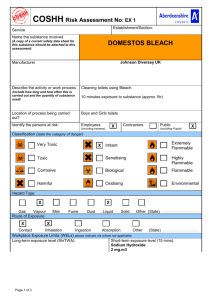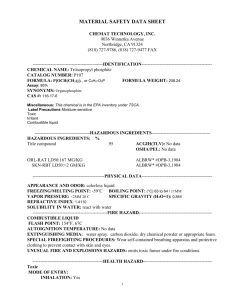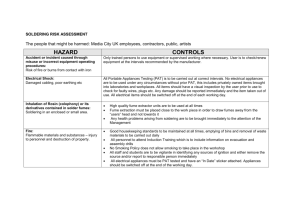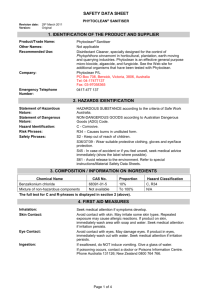Affinity chromatography - University of Westminster
advertisement
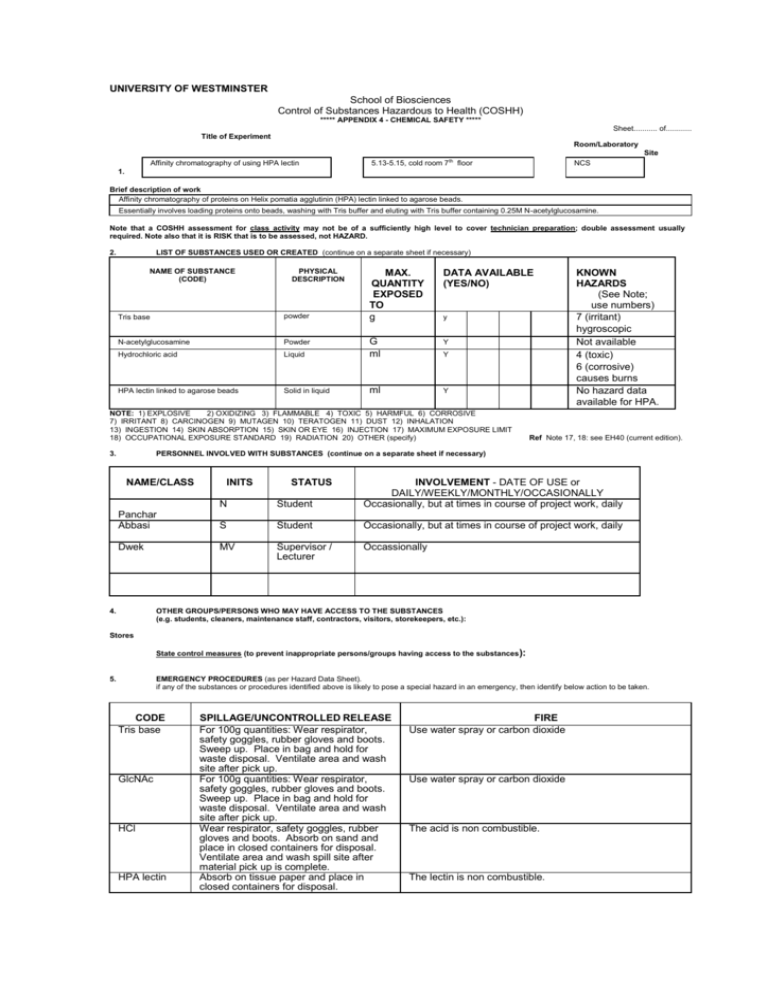
UNIVERSITY OF WESTMINSTER School of Biosciences Control of Substances Hazardous to Health (COSHH) ***** APPENDIX 4 - CHEMICAL SAFETY ***** Sheet........... of............ Title of Experiment Room/Laboratory Site Affinity chromatography of using HPA lectin 5.13-5.15, cold room 7 th floor NCS 1. Brief description of work Affinity chromatography of proteins on Helix pomatia agglutinin (HPA) lectin linked to agarose beads. Essentially involves loading proteins onto beads, washing with Tris buffer and eluting with Tris buffer containing 0.25M N-acetylglucosamine. Note that a COSHH assessment for class activity may not be of a sufficiently high level to cover technician preparation; double assessment usually required. Note also that it is RISK that is to be assessed, not HAZARD. 2. LIST OF SUBSTANCES USED OR CREATED (continue on a separate sheet if necessary) NAME OF SUBSTANCE (CODE) PHYSICAL DESCRIPTION MAX. QUANTITY EXPOSED TO g DATA AVAILABLE (YES/NO) Tris base powder N-acetylglucosamine Powder Liquid G ml Y Hydrochloric acid HPA lectin linked to agarose beads Solid in liquid ml Y y Y NOTE: 1) EXPLOSIVE 2) OXIDIZING 3) FLAMMABLE 4) TOXIC 5) HARMFUL 6) CORROSIVE 7) IRRITANT 8) CARCINOGEN 9) MUTAGEN 10) TERATOGEN 11) DUST 12) INHALATION 13) INGESTION 14) SKIN ABSORPTION 15) SKIN OR EYE 16) INJECTION 17) MAXIMUM EXPOSURE LIMIT 18) OCCUPATIONAL EXPOSURE STANDARD 19) RADIATION 20) OTHER (specify) 3. KNOWN HAZARDS (See Note; use numbers) 7 (irritant) hygroscopic Not available 4 (toxic) 6 (corrosive) causes burns No hazard data available for HPA. Ref Note 17, 18: see EH40 (current edition). PERSONNEL INVOLVED WITH SUBSTANCES (continue on a separate sheet if necessary) NAME/CLASS N Student INVOLVEMENT - DATE OF USE or DAILY/WEEKLY/MONTHLY/OCCASIONALLY Occasionally, but at times in course of project work, daily Panchar Abbasi S Student Occasionally, but at times in course of project work, daily Dwek MV Supervisor / Lecturer Occassionally 4. INITS STATUS OTHER GROUPS/PERSONS WHO MAY HAVE ACCESS TO THE SUBSTANCES (e.g. students, cleaners, maintenance staff, contractors, visitors, storekeepers, etc.): Stores State control measures (to prevent inappropriate persons/groups having access to the substances ): 5. EMERGENCY PROCEDURES (as per Hazard Data Sheet). if any of the substances or procedures identified above is likely to pose a special hazard in an emergency, then identify below action to be taken. CODE Tris base GlcNAc HCl HPA lectin SPILLAGE/UNCONTROLLED RELEASE For 100g quantities: Wear respirator, safety goggles, rubber gloves and boots. Sweep up. Place in bag and hold for waste disposal. Ventilate area and wash site after pick up. For 100g quantities: Wear respirator, safety goggles, rubber gloves and boots. Sweep up. Place in bag and hold for waste disposal. Ventilate area and wash site after pick up. Wear respirator, safety goggles, rubber gloves and boots. Absorb on sand and place in closed containers for disposal. Ventilate area and wash spill site after material pick up is complete. Absorb on tissue paper and place in closed containers for disposal. FIRE Use water spray or carbon dioxide Use water spray or carbon dioxide The acid is non combustible. The lectin is non combustible. If personnel are affected (fumes, contamination, etc.) treatment to be adopted: SPECIFY PER SUBSTANCE (CODE AS PER HAZARD DATA SHEET) Hydrochloric acid: Fumes vacate area to area clear of fumes rest and keep warm. If exposure has been great obtain medical attention. Skin contact wash the area thoroughly under running tap water. Remove contaminated clothing and wash before reuse. Eye contact eye wash bottle irrigate for at least 10 minutes and seek medical advice In the case of significant contamination either of fumes or to skin and ALWAYS to eyes, seek medical advice. Tris base: Inhalation remove to fresh air, fi not breathing, give artificial respiration. If breathing is difficult, medical practitioners should give oxygen Skin contact wash with soap and copious amounts of water. Eye contact eye wash bottle irrigate for at least 10 minutes and seek medical advice In the case of significant contamination either of fumes or to skin and ALWAYS to eyes, seek medical advice. 6. CONTROL MEASURES TO BE ADOPTED (NB. Consider the following points, the appropriate Biosciences Safety Code plus any other necessary measures. SPECIFY PER SUBSTANCE AS NECESSARY FOR EACH OF THE ITEMS BELOW.) Always use HCl in fume cupboard, wear gloves (see COSHH form attached). Always add acid to buffer in small volumes NOT buffer to acid. 1. Limiting exposure time of personnel - state maximum time 2. Partial enclosure with local exhaust ventilation 3. Local exhaust ventilation 4. Sufficient general ventilation 5. Personal protective equipment (goggles/gloves/clothing/mask/breathing apparatus/safety screen, etc.) SPECIFY * 6. Safe disposal/storage of hazardous substances * 7. Regular cleaning of the workplace * 8. Adequate washing facilities * = MANDATORY STORAGE - SAFETY CONSIDERATIONS HCl locked toxic cabinet HANDLING PRECAUTIONS HCl, wear nitrile gloves and safety spectacles / goggles / lab coat. Avoid skin contact. Always use HCl in an extractor hood or fume cupboard.. Tris base shelf in lab Wear nitrile gloves and safety spectacles / goggles / lab coat. Avoid skin contact. DISPOSAL PROCEDURES DURING AND AT END OF EXPERIMENT Dispose of plasticware after autoclaving via laboratory waste route. Dispose of Tris-HCl solutions into drain with large volumes of water to wash away. 7. REVIEW AND MONITORING OF CONTROL MEASURES (Required checks, and their frequency, on the adequacy and maintenance of the control measures during the course of the experiment) (NB. Biosciences Safety Code in respect of health surveillance needs. This form is not adequate if health surveillance is required.) 8. OTHER RELEVANT INFORMATION (continue on a separate sheet if necessary) (e.g. restriction of usage; transportation risks; labelling requirements; assessment review date, etc.) 9. I certify that, to the best of my knowledge, the above precautions will adequately control the risks from the hazardous substances listed. I have brought the assessment to the notice of the relevant technicians; academic staff; students; researchers (delete as necessary). Name of Assessor: Miriam Dwek Signed: Status of Assessor: Lecturer Date:
